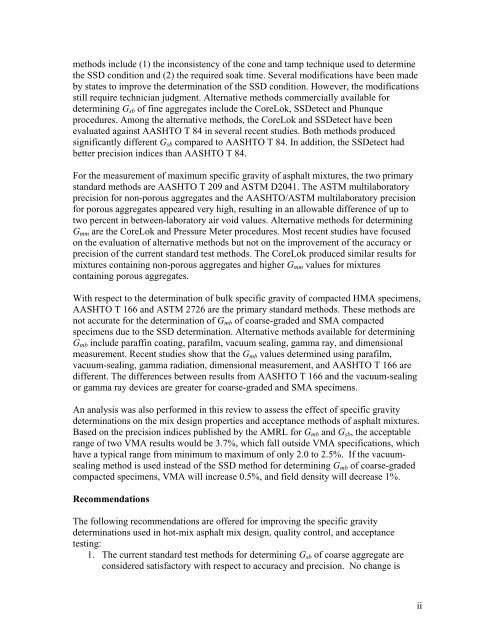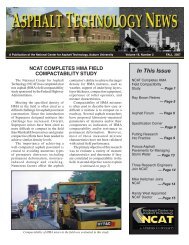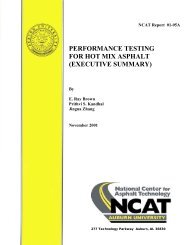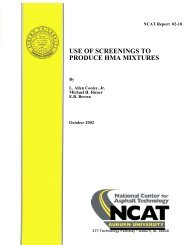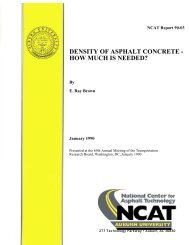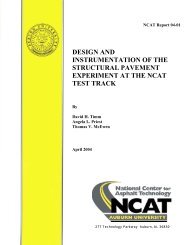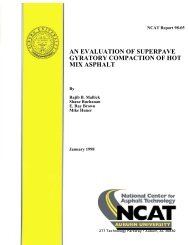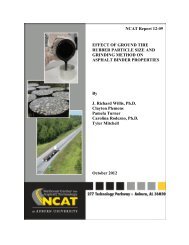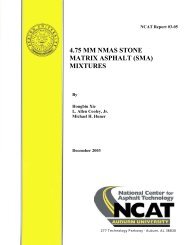A Review of Aggregate and Asphalt Mixture Specific Gravity ...
A Review of Aggregate and Asphalt Mixture Specific Gravity ...
A Review of Aggregate and Asphalt Mixture Specific Gravity ...
Create successful ePaper yourself
Turn your PDF publications into a flip-book with our unique Google optimized e-Paper software.
methods include (1) the inconsistency <strong>of</strong> the cone <strong>and</strong> tamp technique used to determinethe SSD condition <strong>and</strong> (2) the required soak time. Several modifications have been madeby states to improve the determination <strong>of</strong> the SSD condition. However, the modificationsstill require technician judgment. Alternative methods commercially available fordetermining G sb <strong>of</strong> fine aggregates include the CoreLok, SSDetect <strong>and</strong> Phunqueprocedures. Among the alternative methods, the CoreLok <strong>and</strong> SSDetect have beenevaluated against AASHTO T 84 in several recent studies. Both methods producedsignificantly different G sb compared to AASHTO T 84. In addition, the SSDetect hadbetter precision indices than AASHTO T 84.For the measurement <strong>of</strong> maximum specific gravity <strong>of</strong> asphalt mixtures, the two primaryst<strong>and</strong>ard methods are AASHTO T 209 <strong>and</strong> ASTM D2041. The ASTM multilaboratoryprecision for non-porous aggregates <strong>and</strong> the AASHTO/ASTM multilaboratory precisionfor porous aggregates appeared very high, resulting in an allowable difference <strong>of</strong> up totwo percent in between-laboratory air void values. Alternative methods for determiningG mm are the CoreLok <strong>and</strong> Pressure Meter procedures. Most recent studies have focusedon the evaluation <strong>of</strong> alternative methods but not on the improvement <strong>of</strong> the accuracy orprecision <strong>of</strong> the current st<strong>and</strong>ard test methods. The CoreLok produced similar results formixtures containing non-porous aggregates <strong>and</strong> higher G mm values for mixturescontaining porous aggregates.With respect to the determination <strong>of</strong> bulk specific gravity <strong>of</strong> compacted HMA specimens,AASHTO T 166 <strong>and</strong> ASTM 2726 are the primary st<strong>and</strong>ard methods. These methods arenot accurate for the determination <strong>of</strong> G mb <strong>of</strong> coarse-graded <strong>and</strong> SMA compactedspecimens due to the SSD determination. Alternative methods available for determiningG mb include paraffin coating, parafilm, vacuum sealing, gamma ray, <strong>and</strong> dimensionalmeasurement. Recent studies show that the G mb values determined using parafilm,vacuum-sealing, gamma radiation, dimensional measurement, <strong>and</strong> AASHTO T 166 aredifferent. The differences between results from AASHTO T 166 <strong>and</strong> the vacuum-sealingor gamma ray devices are greater for coarse-graded <strong>and</strong> SMA specimens.An analysis was also performed in this review to assess the effect <strong>of</strong> specific gravitydeterminations on the mix design properties <strong>and</strong> acceptance methods <strong>of</strong> asphalt mixtures.Based on the precision indices published by the AMRL for G mb <strong>and</strong> G sb , the acceptablerange <strong>of</strong> two VMA results would be 3.7%, which fall outside VMA specifications, whichhave a typical range from minimum to maximum <strong>of</strong> only 2.0 to 2.5%. If the vacuumsealingmethod is used instead <strong>of</strong> the SSD method for determining G mb <strong>of</strong> coarse-gradedcompacted specimens, VMA will increase 0.5%, <strong>and</strong> field density will decrease 1%.RecommendationsThe following recommendations are <strong>of</strong>fered for improving the specific gravitydeterminations used in hot-mix asphalt mix design, quality control, <strong>and</strong> acceptancetesting:1. The current st<strong>and</strong>ard test methods for determining G sb <strong>of</strong> coarse aggregate areconsidered satisfactory with respect to accuracy <strong>and</strong> precision. No change isii


